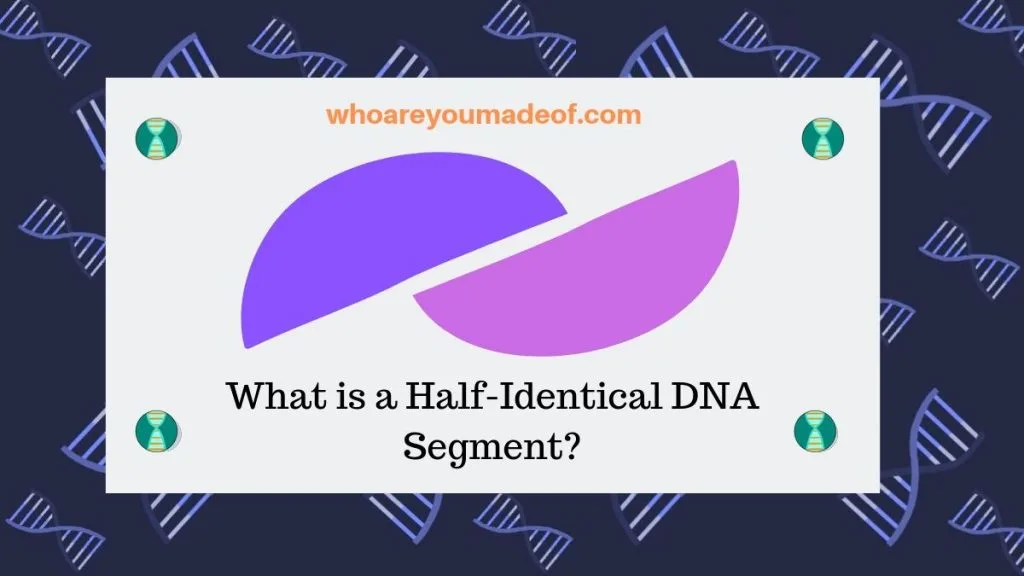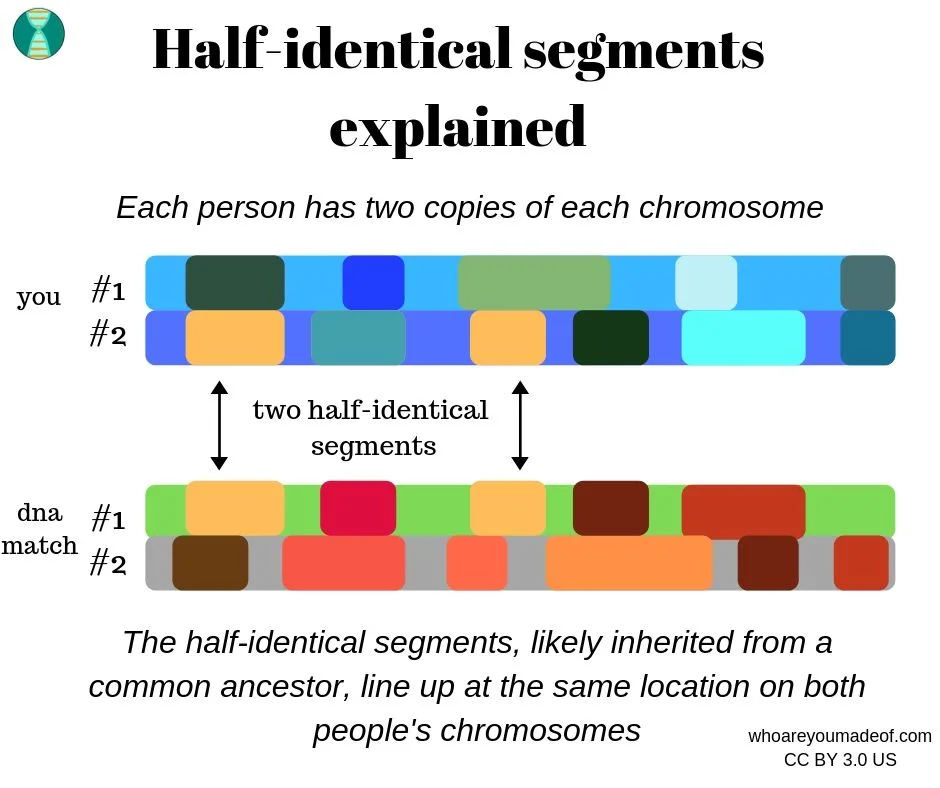Do you want to understand what a half-identical DNA segment is? In this post, you'll learn more about half-identical regions, as well as what it means when you share this type of segment with a match.
As a bonus, you'll also learn the difference between a half-identical and fully-identical segment, and how to identify each.
Half-identical segments, also known as HIRs*, half-match segments, or half-identical regions, are often visible on chromosome browsers. We can spot half-identical segments on sites like Gedmatch and 23andMe where we can examine detailed segment data.
*HIR stands for "half-identical region", which is the technical term for "half-identical segment"

What is a half-identical DNA segment
If you and a DNA match share a half-identical segment, it means that you and your match share identical alleles throughout the entire segment on one copy of the chromosome where the segment is located. This half- identical segment of DNA is called an identical "region".
Everyone, including you and me, inherited two copies of each numbered chromosome from both their mother and father. This means that we have two copies of Chromosome 1, two copies of Chromosome 2, and so on.
A half-identical region is a matching region inherited from only one of of our parents. For example, if you have a half-identical matching DNA segment with a match, it means that you inherited the matching segment from either your mother or your father, but not both of them.
Below is a very simplified visualization of what half-identical DNA segment might look like on a chromosome. Each person has two copies of each numbered chromosome.
As you can see in the image, the two DNA matches used for the example share two light-colored segments. These half-identical regions are different than fully-identical regions which would be identical on both copies of the chromosome.

The above image is simplified to help you easily spot the half-identical segment and imagine how your half-identical segments might look on your chromosomes. In reality, our chromosomes are made up of many, many more DNA segments all inherited from our ancestors.
Those smaller DNA segments were passed down from our ancestors' ancestors. It all gets quite complicated!
What does it mean to share half-identical segment or region with a match?
A half-identical segment was inherited from either your mother or your father, and it means that you might share a common ancestor on one side of your family. Half-identical regions, or segments, that are above 7 centimorgans in length were likely passed down to you in one copy of a chromosome that you inherited from your mother or father.
For example, if I have a half-identical segment that I share with a cousin on the copy of the chromosome that I inherited from my dad, then it is likely that the cousin matches me on my dad's side of the family.
On sites like Ancestry, we don't necessarily know if a segment is half or fully-identical, but can make assumptions among our close matches. For example, if a close cousin matches my dad and not my mom, it's likely that most of our segments are half-identical.
What is the difference between a half-identical and fully-identical segment?
Half-identical segments are regions where the alleles are only identical on one copy of our chromosome, whereas fully-identical regions have identical alleles on both copies of the chromosome.
We usually see fully-identical regions on segments that are shared between siblings, since siblings will inherit matching DNA segments that are identical from both parents. Siblings will have half-identical segments, too, however, since they don't share 100% of their DNA with each other.
People who aren't sure whether their sibling is a full or half-sibling will often find themselves interested in fully-identical regions, since having lots of big fully-identical regions (and sharing, generally, more than 2300 cMs) will indicate two people sharing both parents.
As an aside, people whose parents share common ancestry might find fully-identical regions in both copies their own chromosomes. This can happen if your parents are related to each other, even distantly.
How do you tell if a DNA segment is half-identical or fully-identical?
The only way to tell for sure whether your shared DNA segment is half-identical or fully-identical is for both of you (i.e. you and your match) to upload your "raw" DNA to a site where you can use a chromosome browser. One example (my favorite) of such site is Gedmatch.
Alternatively, you can both do new DNA tests, or uploads, on sites like 23andMe, My Heritage DNA, or Family Tree DNA. These sites allow you to compare your DNA with that of your matches in order to view detailed segment data, including whether a segment is a fully-identical or half-identical match.
Can half-identical segments be false or identical-by-state?
Yes. Half-identical segments, especially very small ones, can be false or identical-by-state (IBS).
Most experts recommend that we completely ignore segments that are smaller than 5-7 centimorgans, since those segments are much more likely to be false (coincidentally identical) segments. I recommend that beginners to genetic genealogy focus on segments that are larger than 10 centimorgans.
The exception to this recommendation would apply if you are able to verify that your very small half-identical segment is identical-by-descent by phasing your matches with your parents' DNA.
Conclusion
I hope that this post helped you understand more about half-identical DNA segments, what it means to share these segments with a match, and how they are different than fully-identical regions.
If you have any questions about something that you read in this post, or would like to share your own experience with half-identical segments, I would love to hear from you in the discussion below.
Thanks for stopping by today!


Les Kopel
Wednesday 21st of June 2023
If men inherit only one copy of the X chromosome, how is it possible that my 1st cousin and I, both men, share a long, fully-identical segment on each of our respective X chromosomes? Tested on 23&Me.
Tim
Sunday 11th of September 2022
Interesting I never knew that because me and my eldest brother share over 2,300 Centimorgans of Identical DNA Segments? Also most of my DNA Matches I share fully Identical DNA Segments with as low as 60 Centimorgans across 3 Segments and a little bit more at 109 Centimorgans of DNA across 5 Segments?
MarPetry
Wednesday 20th of October 2021
Good evening,
Ok.. I sort of understand what is being said here on the "half-identical". I read Mercedes reply about "The only relatives we will share big fully-identical segments with are our full siblings because we will have matching DNA on both copies of the chromosomes from both sides of the family". My sister and I are on the same site - it has always indicated "half-sister" - I ran the DNA segment comparison: (Half identical, 1584 cM, 41 segments) - to be honest, looking back, this would make sense but you can't be 100% sure unless you both go in and run tests?
Thank you for your time, Mar
Kim
Saturday 28th of January 2023
@MarPetry, perhaps you are not full siblings since the amount of DNA you share with your sister is 1584cM. According to Blaine Bettinger's Sharded cM Chart, Typically full siblings share 1613 - 3488 cM of DNA. I suppose their could be exceptions, but it appears on the surface of things that your sister is a half sister, not a full sister.
Kitty Prince
Monday 24th of August 2020
Is it possible for someone to have half identical Mark's to be a closer relative than cousins?
Mercedes
Tuesday 25th of August 2020
Hi Kitty, Almost every DNA segment we share with our relatives, even close ones, will be half-identical. The only relatives we will share big fully-identical segments with are our full siblings because we will have matching DNA on both copies of the chromosomes from both sides of the family. This means that we will share half-identical segments with aunts, uncles, grandparents, grandchildren, half-siblings, etc - all close relatives who are a little closer than first cousins. I hope that this explanation helps! Mercedes
Dawn Gable
Wednesday 19th of August 2020
Thanks!